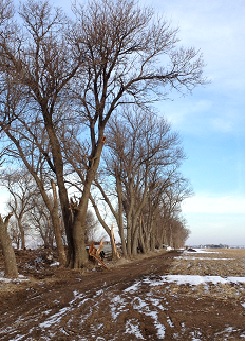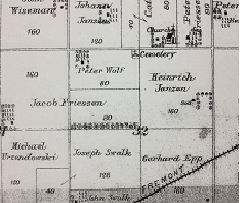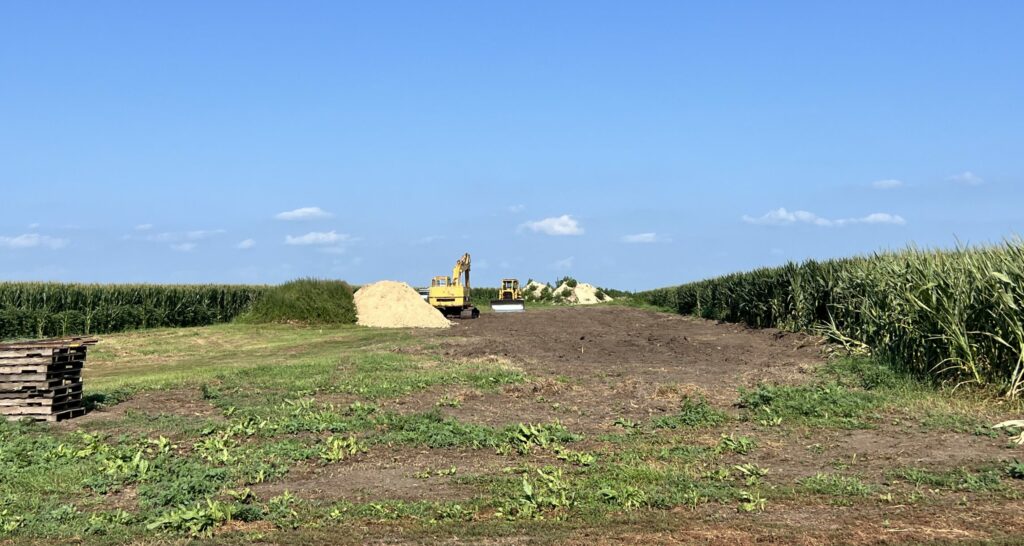This article, “Henderson Landmark Disappearing,” was actually written in 2013, but I thought it was timely to reprint it now that the Henderson landmark has disappeared. The familiar half-mile line of trees on the north edge of Henderson has been thinned out over the past 11 years, and today, the job is finished, and they are gone. This 100-plus-year-old unique shelter belt has some history and stories to tell worth remembering!

This picture of the shelter belt was taken in 2013 when work first began removing trees.
If you haven’t noticed, a landmark north of Henderson is disappearing.
It’s a 1/2 mile-long shelter belt that has been there for well over 100 years. A few years ago, I was curious enough about these trees and the road between them that I rode my bike out there to see for myself what it was like. I found the lane still pretty drivable for a bike, and the towering trees made it a shady, quiet place. It was littered with stacks of aluminum irrigation pipe and a few farm implements.
But things change, and this longstanding shelter belt with its driveway has no purpose in today’s farming. The width of the shelter belt has made it more difficult to farm these two pieces of land over the years. With the change in irrigation from pipe to pivots, the trees interfered with the circular path of the pivots. Russ Regier and John Huebert, who farmed on each side of it, had to haul irrigation pipe every season to fully irrigate both these sections of land.
That is the reason for the near removal of the trees. Huebert Land Leveling has been working on the job for several months. The trees at the east end were totally removed to make way for the pivots. What you see now is what will remain of the shelter belt after all the dead and dying trees are thinned out.

This is a picture of an 1889 plat map actually showing the line of trees on the land owned by Jacob Friesen, who immigrated to Henderson from Russia in 1874. Homesteaders were encouraged to plant windbreaks by the Timber Culture Act of 1873, which gave title to land when they planted 10-40 acre blocks of trees. It is believed that Friesen took advantage of this act by planting a substantial windbreak, as shown here on the map.
The descendants of Jacob and Anna Friesen owned the land until 13 years ago when it was sold to Martha Regier, and her son Russ Regier farms it. John Huebert owns the land on the south side of this unusual shelter belt. It’s unusual because it actually was two rows of trees with a road down the middle. According to Clarence Friesen, Emil Friesen, grandson of Jacob Friesen, believed that the original windbreak was several rows of solid trees, and later, when it was replanted, the driveway was created.
As most landmarks do, this one holds much history for Henderson. Old-timers called it the “holt” or “timba”, which in Low German meant woods or a bunch of trees. The section of land where the trees are was settled by three families who decided by lots who would purchase the quarter where they would live. That is where the term Drei Rose came from which in Low German means three roses. The story goes that these three families, Jacob and Anna Friesen, Johann and Anna Friesen (Anna’s parents), and Heinrich and Sara Epp (Mrs. Johann Friesen’s sister), each had a different rose bush planted in their yard.
Amy Friesen, the only living direct descendant of Jacob Friesen, remembers the yard where she grew up having a yellow rose bush. Her grandfather was Jacob Friesen, and her father, G.J. Friesen, was what she called a Johnny-come-lately baby and was the youngest of Jacob and Anna’s seven children. Her family lived in Jacob Friesen’s home place which is where the Joe Eck farmstead is today.
It was near this shelter belt that Jacob Friesen braved the famous Blizzard of 1888 to find his missing children. Three of his children had gone to visit their older brother John and got caught in this horrific storm. They made it past the trees, which helped guide them, and ended up taking shelter in a haystack near where Bruce and Susan Hiebner live.
One of Suzanne Ratzlaff’s fourth-grade classes in 1998 researched this famous storm and the story surrounding Jacob Friesen’s rescue of his children. They were recognized and received an award for their class project. Their project can be found on The Library of Congress website at: http://www.americaslibrary.gov/es/ne/es_ne_blizzard_1.html
Adeline Huebert remembers stories that her great grandfather John W. Friesen, the eldest son of Jacob Friesen, told about one of the years that he and his sister Anna didn’t attend school. That year, they spent much of their time watering these very trees.
Clarence Friesen, grandson of John W. Friesen, grew up on the farmstead 1/2 mile east of the shelter belt. He remembers his family driving a horse and buggy to town through the driveway in between the trees. “It was handy to go to town through the trees because we then didn’t have to use the steep railroad crossing that could be difficult with horses,” said Friesen. The driveway was practical because it allowed these families a nice shortcut either to town or to each other’s farmsteads instead of having to go the long way around the section.
Amy Friesen recalls her family shocking wheat next to the shelter belt. “While Mom and Dad shocked wheat, we younger children were loaded up in the spring wagon, and my older sister Mildred took care of us. She fed my brothers Jim, Allen, and me animal crackers in the wagon while they worked,” said Friesen.
Our landscape has forever changed with the near removal of this landmark, but it’s good to be reminded of the stories and history behind this unique shelter belt that stood for over a hundred years. If you have a story or memory to share about this landmark, please contact me at: mshannon.siebert@gmail.com

Today, the shelter belt has been completely removed, with only the dirt work remaining.
































